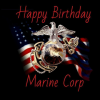BarnBuster
Virtually Unknown Member

On November 10, 1775, the Second Continental Congress meeting in Philadelphia passed a resolution stating that "two Battalions of Marines be raised" for service as landing forces with the fleet. This resolution established the Continental Marines and marked the birth date of the United States Marine Corps.


















